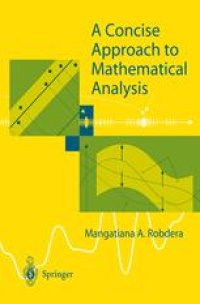
Ebook: A Concise Approach to Mathematical Analysis
Author: Mangatiana A. Robdera (auth.)
- Genre: Mathematics // Analysis
- Tags: Analysis, Real Functions, Difference and Functional Equations, Fourier Analysis, Sequences Series Summability
- Year: 2003
- Publisher: Springer-Verlag London
- Edition: 1
- Language: English
- pdf
A Concise Approach to Mathematical Analysis introduces the undergraduate student to the more abstract concepts of advanced calculus. The main aim of the book is to smooth the transition from the problem-solving approach of standard calculus to the more rigorous approach of proof-writing and a deeper understanding of mathematical analysis. The first half of the textbook deals with the basic foundation of analysis on the real line; the second half introduces more abstract notions in mathematical analysis. Each topic begins with a brief introduction followed by detailed examples. A selection of exercises, ranging from the routine to the more challenging, then gives students the opportunity to practise writing proofs. The book is designed to be accessible to students with appropriate backgrounds from standard calculus courses but with limited or no previous experience in rigorous proofs. It is written primarily for advanced students of mathematics - in the 3rd or 4th year of their degree - who wish to specialise in pure and applied mathematics, but it will also prove useful to students of physics, engineering and computer science who also use advanced mathematical techniques.
A Concise Approach to Mathematical Analysis introduces the undergraduate student to the more abstract concepts of advanced calculus. The main aim of the book is to smooth the transition from the problem-solving approach of standard calculus to the more rigorous approach of proof-writing and a deeper understanding of mathematical analysis. The first half of the textbook deals with the basic foundation of analysis on the real line; the second half introduces more abstract notions in mathematical analysis. Each topic begins with a brief introduction followed by detailed examples. A selection of exercises, ranging from the routine to the more challenging, then gives students the opportunity to practise writing proofs. The book is designed to be accessible to students with appropriate backgrounds from standard calculus courses but with limited or no previous experience in rigorous proofs. It is written primarily for advanced students of mathematics - in the 3rd or 4th year of their degree - who wish to specialise in pure and applied mathematics, but it will also prove useful to students of physics, engineering and computer science who also use advanced mathematical techniques.
A Concise Approach to Mathematical Analysis introduces the undergraduate student to the more abstract concepts of advanced calculus. The main aim of the book is to smooth the transition from the problem-solving approach of standard calculus to the more rigorous approach of proof-writing and a deeper understanding of mathematical analysis. The first half of the textbook deals with the basic foundation of analysis on the real line; the second half introduces more abstract notions in mathematical analysis. Each topic begins with a brief introduction followed by detailed examples. A selection of exercises, ranging from the routine to the more challenging, then gives students the opportunity to practise writing proofs. The book is designed to be accessible to students with appropriate backgrounds from standard calculus courses but with limited or no previous experience in rigorous proofs. It is written primarily for advanced students of mathematics - in the 3rd or 4th year of their degree - who wish to specialise in pure and applied mathematics, but it will also prove useful to students of physics, engineering and computer science who also use advanced mathematical techniques.
Content:
Front Matter....Pages i-xiii
Numbers and Functions....Pages 1-33
Sequences....Pages 35-64
Series....Pages 65-94
Limits and Continuity....Pages 95-121
Differentiation....Pages 123-144
Elements of Integration....Pages 145-175
Sequences and Series of Functions....Pages 177-211
Local Structure on the Real Line....Pages 213-240
Continuous Functions....Pages 241-269
Introduction to the Lebesgue Integral....Pages 271-311
Elements of Fourier Analysis....Pages 313-338
Back Matter....Pages 339-366
A Concise Approach to Mathematical Analysis introduces the undergraduate student to the more abstract concepts of advanced calculus. The main aim of the book is to smooth the transition from the problem-solving approach of standard calculus to the more rigorous approach of proof-writing and a deeper understanding of mathematical analysis. The first half of the textbook deals with the basic foundation of analysis on the real line; the second half introduces more abstract notions in mathematical analysis. Each topic begins with a brief introduction followed by detailed examples. A selection of exercises, ranging from the routine to the more challenging, then gives students the opportunity to practise writing proofs. The book is designed to be accessible to students with appropriate backgrounds from standard calculus courses but with limited or no previous experience in rigorous proofs. It is written primarily for advanced students of mathematics - in the 3rd or 4th year of their degree - who wish to specialise in pure and applied mathematics, but it will also prove useful to students of physics, engineering and computer science who also use advanced mathematical techniques.
Content:
Front Matter....Pages i-xiii
Numbers and Functions....Pages 1-33
Sequences....Pages 35-64
Series....Pages 65-94
Limits and Continuity....Pages 95-121
Differentiation....Pages 123-144
Elements of Integration....Pages 145-175
Sequences and Series of Functions....Pages 177-211
Local Structure on the Real Line....Pages 213-240
Continuous Functions....Pages 241-269
Introduction to the Lebesgue Integral....Pages 271-311
Elements of Fourier Analysis....Pages 313-338
Back Matter....Pages 339-366
....